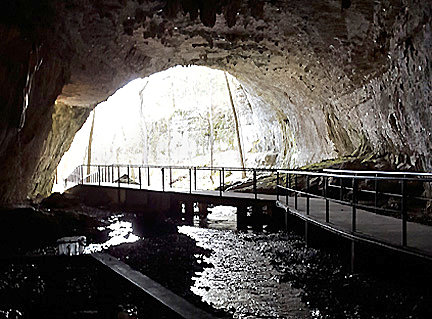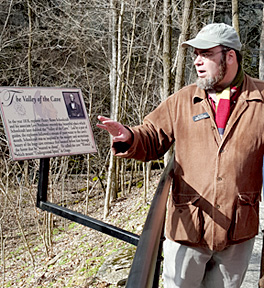
The entrance to Smallin Cave in Christian County, Missouri is seen from several hundred yards within.
by Mari Winn Taylor
Six miles south of Springfield near the town of Ozark is a cave that gets mentioned from time to time by historians at Wilson's Creek National Civil War Battlefield. It's claim to fame allows it to be known as the Smallin Civil War Cave: "Smallin" because Tennesseans Elbridge Gerry Smallin and his second wife Jane (nee Stapp) settled in about 1860 on land that encompassed the site of the cave and "Civil War Cave" because, according to folklore, it served as a hideaway for the supplies of Union troops from Camp Brown in the nearby village of Ozark that were readying for the fight at Wilson's Creek. More widely documented is the use of Smallin Cave during the war as a place of refuge for Union spy, John Breazeales. When the cave was purchased by Joseph Bolger in the 1950s, he called it "Civil War Cave" and through the 1960s he conducted tours there after installing concrete walkways. However in referencing the name change, StateoftheOzarks.net writes:
"Who does he think he is? was the general sentiment of the Finley River and Parch Corn Holler community. Thats not Bolgers cave. Thats Smallins Cave!"
After the Civil War the history of the cave was tied to the "vigilante" group known as the Baldknobbers. An historic marker at the square in downtown Ozark documents their connection to the area. Eye witnesses to their eventual executions passed down to future generations their accounts, including how one of the Baldknobbers had to be hung twice because the method obviously failed the first time.
 Eric Fuller, our guide for a tour of Smallin Cave calls attention to a plaque along the trail. "The Valley of the Cave" in which we stood was so named by geographer and geologist, Henry Rowe Schoolcraft, who with his associate Levi Pettibone discovered the area during their expedition across Missouri in 1818. Eric Fuller, our guide for a tour of Smallin Cave calls attention to a plaque along the trail. "The Valley of the Cave" in which we stood was so named by geographer and geologist, Henry Rowe Schoolcraft, who with his associate Levi Pettibone discovered the area during their expedition across Missouri in 1818.
A petroglyph or carving of a sun symbol on a wall in the cave, suggests the presence of Indian tribes marking the distance of light within the cave. Eric Fuller, one of Smallin Cave's staff archaeologists and tour guides, made a point of showing how far light penetrates the cave. Granted the cave has the largest entrance in Missouri at 100-feet wide and 55-feet tall, Fuller's remark came over 300 feet from the entrance. The cave is positioned to catch the rays of the sun and in so doing register the shortest day of the year.
The symbol may mark the end of the fall hunt, Fuller suggested. He said that the Osage, who dominated the Ozarks for centuries, called the cave "Winoca," or "underground spirit." Fuller revealed that he is planning on publishing a book soon about tribal influence on the cave.
The footprints of the Cherokees also graced the cave during what became known as the "Trail of Tears." A documented stay includes the family of William Stacy--his Cherokee wife and his son, then about 10, who later became a doctor.
Photographs show the fact that for decades the cave became a social gathering place taking advantage of its natural air conditioning. A plaque near the entrance references the religious aspect of the property. It was owned by Springfield's Central Assembly of God. Many can recall being part of Camp SonRise during its three decades of operation.
In the spring of 2010 the Smallin Civil War Cave again became a tourist attraction after its puchase by Kevin and Wanetta Bright, entrepreneurs relocating from Branson. Wanetta had previously gained commercial experience working for the Herschends at Silver Dollar City's Marvel Cave.
An hour or a more adventurous two-hour "Wild Tour" is offered at Smallin Cave. While the shorter tour affords the visitor an easy hike and a running commentary that includes anecdotal information plus a lesson in geology, the trek beyond the concrete trails and lights wading through somewhat chilly water, allows participants to discover more than just an occasional bat but the cave salamanders and crayfish and ancient artifacts that may be hidden within. However, the shorter trek was enjoyable, the setting for the cave quite scenic. No fancy lights illuminate the walls, just natural light that displays interesting formations, running water and my favorite, tufa, or layers of moss that looked like velvet.
Outside of the entrance are entertaining hens, a sluice mining experience (it wasn't operating at the time) and a crawl box, 55-feet of wooden passageways to belly through and brag over one's success. There's an opportunity to purchase a photograph taken in the cave as well as other items from the gift shop labeled one-of-a-kind.
Business, of course, slows down in January and February. Tours only are offered when weather permits. Phone (417) 551-4545 for hours, admission fees, and directions to get there.
These photographs were taken in the morning, the day before Christmas 2015. Click on any thumbnail to activate a slideshow.
Go Back | 






